I’ve been seeing snakes (well, a snake) off and on for the past couple of months in our back yard, but only on a couple of these occasions have I had my camera with me and been able to get a few shots. The snake in question is one of the more common ones in our area, Coluber constrictor, the Southern Black Racer.
While I am always quite pleased to find snakes, they prefer to remain unfound; every time I see this guy he tells me by his actions that he is not very pleased to be discovered. When I first saw it with camera back in February, it went so far as to initiate its threat display, which consists of shaking its tail rather quickly back and forth. Because it was situated in some dry grasses (this was during the dry season here in south Florida and, as usual, we were in the middle of a terrible drought, although the rainy season has come early since then), when it shook its tail it made a rather ominous-sounding rattle. Since I knew it to be nonvenomous, I pursued it anyway, so that you could get a look at it.
Here you can see it peeking out from between two pots in the gardening storage area:
These are pretty harmless snakes, and as with many of the animals that people tend to fear (wasps, anyone?), they are actually more beneficial than harmful. After all, among the many prey items in their diet, first on the list are the ones we like the least in our homes: vermin! So, I welcome their presence on the premises. To be more specific about what they eat, we can consult my copy of Gibbons & Dorcas (Snakes of the Southeast):
Racers probably have a more diverse diet than any other North American snake. The wide variety of prey items includes small rodents, lizards, other snakes (including smaller racers), birds, frogs, insects, and even small turtles.
These snakes are visual hunters, often holding their head up high like a periscope to get a good view of their intended prey. Upon sighting a prey item, they chase it down, seize it, and swallow it whole. (No snake is capable of tearing up a meal into bite-sized chunks; if the animal is larger than the snake’s jaws, no problem—they just unhinge their jaw until their gape can accommodate it!)
One personal bonus for me on sighting this species was that it got me to look once again at the description of this species in Gibbons & Dorcas, and there on the first page was the picture of my mystery baby snake from last year! While that individual may not be the one I saw today, it’s not impossible by any stretch of the imagination!
Here’s that baby snake again:
And here’s the picture in the guide book:
I’d have to say it’s a pretty strong match.
About three months after that dry-season encounter, I saw the snake again shortly after the rainy season had started. He appears well fed, and this time (assuming it’s the same one) I was able to get a slightly better set of photos of this guy. He’s about three feet long now and still hanging around keeping the place as vermin-free as he can:
Since he was in the bushes instead of the grasses where he can “race,” I was able to get to within a foot or so of his head. I could have reached out and grabbed him had I been the kind of person who likes to capture snakes. I always like to think that I am that guy (what self-respecting naturalist doesn’t want to handle the subjects under investigation?), but it turns out I’m not. I don’t always have the specific reasons in mind, but how’s this example, from Greene (1997), of why I might not want to handle a black racer?
The Racer (Coluber constrictor) illustrates the responses of many slender, unicolored, fast-moving species of snakes. A startled adult Racer reacts by violent undulatory movement that quickly changes to rapid, graceful locomotion for thirty meters or more. If startled at very close range, a Racer sometimes coils with its head hidden and writhes, smearing scent gland secretions over its body. Alternatively, the snake assumes an S-coil, vibrates its tail, and strikes repeatedly. If seized, a Racer continues to bite and discharge its cloacal contents, while twisting its entire body so strongly that sometimes the tail is broken off. Juvenile Racers have a boldly spotted color pattern and probably rely more heavily on camouflage for escape from predators than do adults.
I have yet to net a butterfly or wasp, and I have yet to do more than admire the snakes and lizards I’ve photographed. And I have to say, they are often worthy of admiration:
It takes all kinds, right?
References
Ashton, R. & Ashton, P. (1988). Handbook of Reptiles and Amphibians of Florida, Part 1: The Snakes. Miami, FL: Windward.
Gibbons, W. & M. Dorcas. (2005). Snakes of the Southeast. Athens, GA: U of Georgia P.
Greene, H. (1997). Snakes: The Evolution of Mystery in Nature. Berkeley, CA: U of California P.

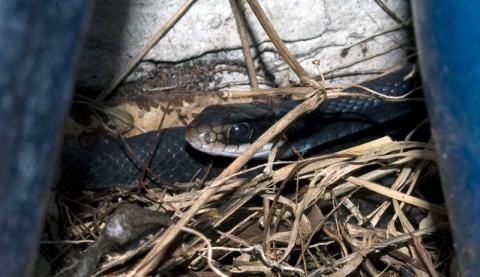
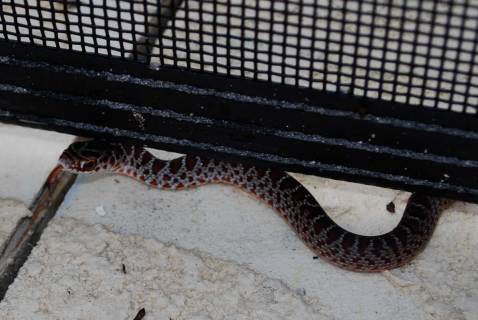
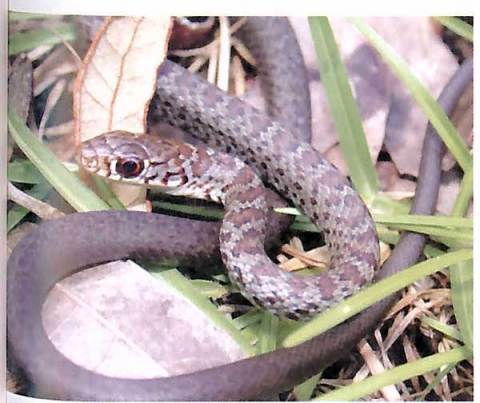
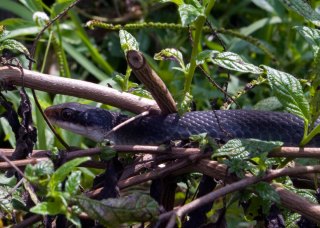
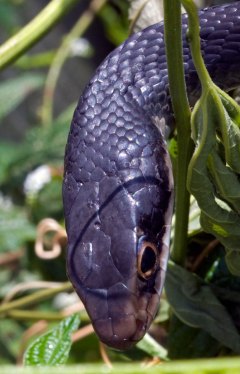
1 thought on “New backyard herp: Coluber constrictor, Southern Black Racer”